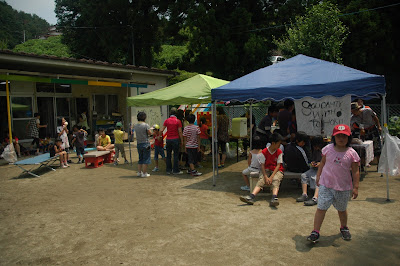On July 26, SWTJ traveled to the area of Rikuzentakata, one of the towns on the Sanriku coast that have been nearly completely washed away by the March 11 tsunami. We met evacuees who now live in temporary barracks built on high ground in the vicinity of where their former town used to be. We cooked hot meals for the 100 people living in the barracks, and talked with them about their worries and prospects.
A view of gas containers that serve the barracks. In the fields beyond, there are still a lot of debris carried inland by the tsunami.
As always, we organized a small event for and with the people at the barracks. Our musicians Nao Masaki and Yoko Shimomura were enthusiastically welcomed by the evacuees.
Sugar candy is especially popular with the elderly. This special sweet evokes memories of childhood, home, and better times.
SWTJ director Yasuo Yoshikawa talks and relaxes with evacuees under a tent in the barrack-village.
The barrack-village has a multi-purpose space where we made our last preparations for dinner for the 100 evacuees who live there. This photo shows a meal for one person, including rice, egg, vegetables and some pork.
This time too, we not only provided food, but took time to talk with the evacuees. In the village that was here once, most families made their living from fishing. Now, however, they have lost family, friends, their homes, boats, jobs, and income. When we made traditional octopus dumplings for the kids, a fisherman promised he would send us some of his octopus catch once he would be able to go back to work.At SWTJ, we keep in contact with the people we meet in order to establish long-term relationships. We facilitate networking with other areas so that evacuees can rebuild their own future.
'Solidarity' means not only support, but sharing responsibility and working together to make things better. SWTJ keeps the discussion with the people affected by the March 11 disaster alive in order to help them build networks useful for reconstruction and for a productive future of their area.
Text and photos: Kanazawa Daisuke(Translated and edited for the English version by B.Y.)
July 27: Summer event at the Furumachi Child Center in Kesennuma
A view of gas containers that serve the barracks. In the fields beyond, there are still a lot of debris carried inland by the tsunami.
As always, we organized a small event for and with the people at the barracks. Our musicians Nao Masaki and Yoko Shimomura were enthusiastically welcomed by the evacuees.
Sugar candy is especially popular with the elderly. This special sweet evokes memories of childhood, home, and better times.
SWTJ director Yasuo Yoshikawa talks and relaxes with evacuees under a tent in the barrack-village.
The barrack-village has a multi-purpose space where we made our last preparations for dinner for the 100 evacuees who live there. This photo shows a meal for one person, including rice, egg, vegetables and some pork.
This time too, we not only provided food, but took time to talk with the evacuees. In the village that was here once, most families made their living from fishing. Now, however, they have lost family, friends, their homes, boats, jobs, and income. When we made traditional octopus dumplings for the kids, a fisherman promised he would send us some of his octopus catch once he would be able to go back to work.
At SWTJ, we keep in contact with the people we meet in order to establish long-term relationships. We facilitate networking with other areas so that evacuees can rebuild their own future.
'Solidarity' means not only support, but sharing responsibility and working together to make things better. SWTJ keeps the discussion with the people affected by the March 11 disaster alive in order to help them build networks useful for reconstruction and for a productive future of their area.
Text and photos: Kanazawa Daisuke
(Translated and edited for the English version by B.Y.)
July 27: Summer event at the Furumachi Child Center in Kesennuma
On July 27, we organized an event at the Furumachi Child Center in Kesennuma. We were warmly welcomed back, since we had been visiting this center already during our third trip to Tohoku. At that time, we had heard that the traditional summer festival held in the area had been canceled because of the disaster. We had then promised that we would be back in the summer, and that we would hold a small summer event for the child center.
At the event, we organized a little street picture book show (kami-shibai) which was much loved by the kids. SWTJ Office Head Junpei Yamanaka acts as the narrator.
The show continued with the appearance of SWTJ representative Yoshikawa in middle-eastern wear.
Kids love to make their own cotton candy.
The Furumachi Child Center in Kesennuma is located on a high hill and was thus spared from the high waves of the tsunami. The center has become a gathering place for both, families affected by the disaster, and those who were spared. Some of the kids who come here have lost one or both parents or siblings, while others have lost their home and live in evacuation centers or with relatives or acquaintances. Our event allowed both adults and kids to relax, talk, network and gain new energy through communication and contact with people from outside.
Everybody enjoys a relay game.
Many of the parents, caretakers, and children remembered us from the last time we were here and were happy to see us again. By returning to the same places, we slowly build trust, and a basis for continued cooperation.
Photos: Ueda Yuko and Kanazawa Daisuke
Text: Kanazawa Daisuke
(Translated and edited for the English version by B.Y.)













No comments:
Post a Comment